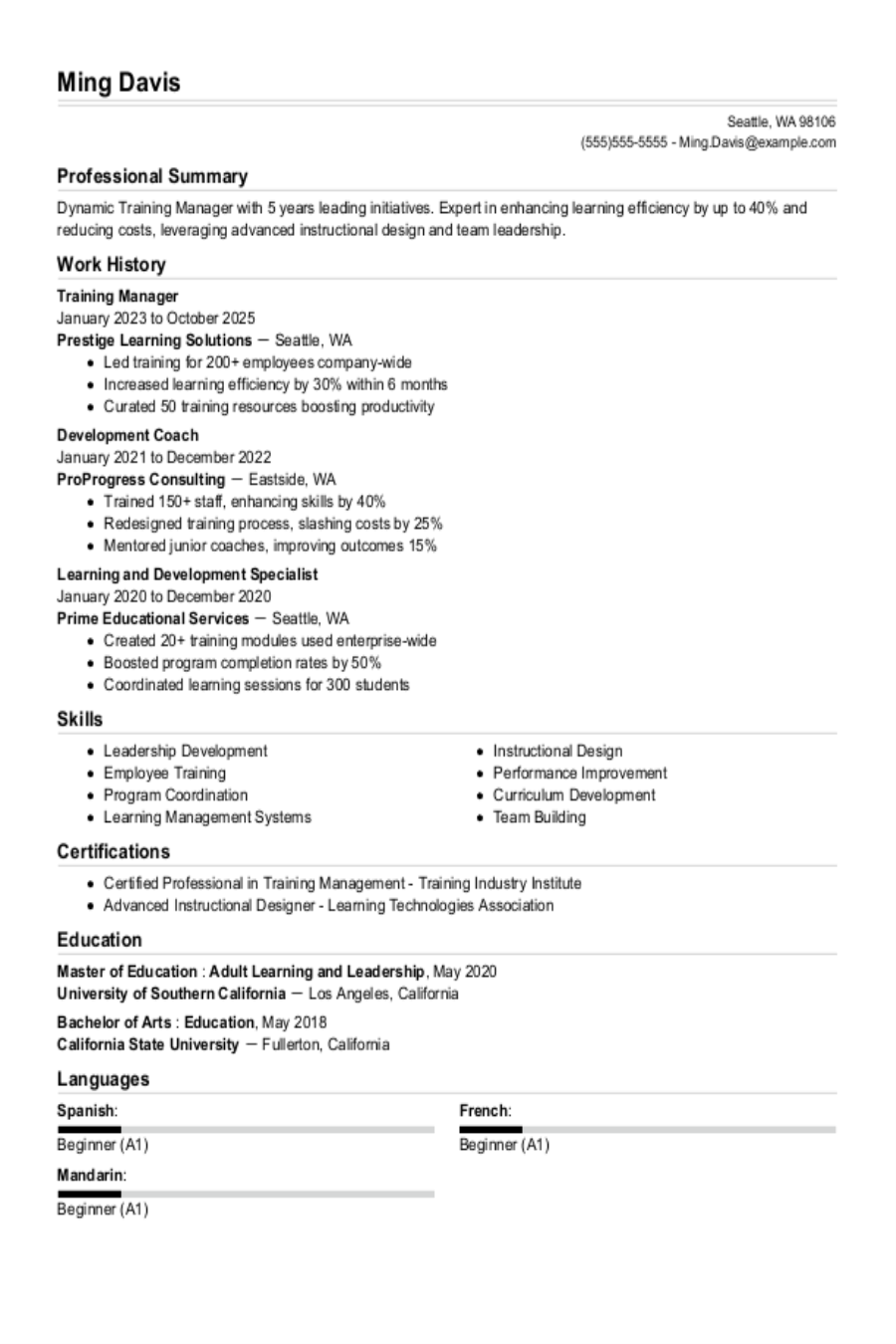If you have a job interview coming up, be ready to answer behavioral questions. Employers want to understand what you can do and how you approach tasks and challenges. Plus, your previous performance might offer insight into how you’d handle issues in the future.
If you’re not sure how to approach behavioral questions, don’t worry! We’ve got you covered.
This guide will help you:
- Understand the purpose of behavioral interview questions.
- Use the STAR method effectively for any of these questions.
- Prepare for 25+ specific behavioral interview questions.
- Look ahead to how you’ll be evaluated by the interviewer.
Let’s jump into it.
Related Guides & Tips
What Are Behavioral Interview Questions?
A behavioral question is a type of interview question that asks candidates to describe specific situations they’ve faced in the past and how they handled them.
These questions focus on real-life experiences that allow employers to assess your skills, decision-making process and how you respond to challenges.
Unlike traditional questions that focus on skills or hypothetical scenarios, these questions ask you to share specific examples.
Traditional questions like “What are your strengths and weaknesses?” are more surface-level and open to rehearsed responses — telling the interviewer exactly what they want to hear.
Behavioral interview questions challenge you with prompts, such as “How did you deal with X?” or “Tell me about a time you faced Y?”
Why do employers ask behavioral questions?
While there are many reasons employers use these questions, we can boil it down to a few:
- Predict future performance: Employers hope to learn how you think through future issues by hearing how you’ve dealt with challenging situations in the past.
- Evaluate problem-solving abilities: Employers want to know they’re hiring someone capable of thinking critically and handling complex problems, which are necessary skills for almost any profession.
- Ensure you’re aligned with company values: Your answers help employers gauge whether your work values and approach align with the company’s culture, which can help predict high performance.
- Add an element of fairness: Since every candidate is asked to share specific examples, employers can objectively assess how well your experiences align with the role’s requirements. This helps them make informed decisions about who will be the best fit for the job.
Ultimately, they hope your answers shed light on your thought process, with each question tied to a core competency, ranging from soft skills to hard skills.
But, what is the best way to organize your answers to behavioral interview questions? The STAR Method.
How to Use the STAR Method for Behavioral Interview Questions
The STAR Method is a structured approach to answering behavioral interview questions, ensuring your responses quickly and clearly demonstrate your impact as an employee.
STAR stands for Situation, Task, Action and Result, which organize your answer as such:
- Situation: Describe a specific situation or challenge you faced at work. Keep it relevant to the question and provide enough detail to give context.
- Task: Explain your role in the situation and the specific challenge or responsibility you needed to address.
- Action: Detail the specific steps you took to handle the situation. Focus on your individual contributions and the reasoning behind your decisions.
- Results: Share the outcome of your actions, emphasizing the positive impact. Whenever possible, quantify your results with metrics or measurable achievements.
Each part of a STAR answer builds off the previous one to outline a compelling story that highlights your skills and achievements.
One way to prepare for behavioral interview questions is to reflect on your previous roles. Your resume is a great resource for this purpose.
For example, if you know you’ll be asked how to handle tough deadlines, look at your work history. Is there an achievement that aligns with this issue?
Ultimately, the STAR Method works well as a template. We recommend breaking your answer into the four steps in the acronym — situation, task, action and results.
Here’s a perfect example of the STAR method.
The question is, “Can you describe a time when you went above and beyond to handle a difficult customer or client?”
Situation: As a customer service representative at BZ Electronics, we had a customer who had purchased a high-end laptop but was experiencing repeated technical issues with it. He had returned the product twice, and on his third call, he was understandably frustrated, claiming he would never buy from us again.
Task: My task was to address and resolve his immediate technical concerns, rebuild his trust in our brand and make sure he was satisfied.
Action: Instead of just going through the usual troubleshooting steps, I assured him that I would personally oversee the resolution of his issue. After the diagnostic process, I realized it might be a more intricate hardware problem. I coordinated with our technical team and arranged a home visit to address the issue. Additionally, I offered him a complimentary accessory for his laptop as a gesture of goodwill for the trouble he faced.
Results: After the home visit, the technical issue was completely resolved. The customer expressed his gratitude for the personalized service and later emailed my manager to say thank you. He continued to buy from BZ Electronics and became a vocal advocate for our brand.
Notice how the answer clearly lays out the situation, the task ahead of the candidate, the actions they took to resolve the issues and the results they generated.
Next, we’ll help you prepare for some of the more common situational interview questions. While it’s impossible to cover them all, we can certainly touch on the big ones.
25+ Behavioral Questions and Answers
Here are some great examples of answers for common behavioral interview questions. Every answer is provided using the STAR Method.
The following categories are covered to give you a well-rounded selection of behavioral questions with answers.
- Time management questions.
- Teamwork and collaboration questions.
- Communication questions.
- Client relationship questions.
- Adaptability and change questions.
- Leadership and initiative questions.
- Value alignment questions.
Time management
How do you prioritize tasks during a particularly stressful day?
Situation: In my previous role as a project manager, I often faced tight deadlines. One particular day, two major projects had overlapping timelines due to unforeseen delays.
Task: I needed to efficiently prioritize the tasks to ensure that both projects moved forward without compromising the quality of work or missing any deadlines.
Action: I used the Eisenhower Box method to categorize tasks into four categories: urgent and important, not urgent but important, urgent but not important and neither urgent nor important. Then, I delegated tasks that could be managed by other team members to spread the workload, then clearly communicated with clients to update them on progress and any necessary timeline adjustments.
Results: By organizing and delegating tasks, we survived the high-pressure day. Both projects progressed as needed and no deadlines were missed. The clients appreciated the transparent communication and the team felt empowered as they had clear directions on their responsibilities.
Can you describe a time when you had to juggle multiple deadlines?
Situation: While working as a marketing coordinator, there were instances where I had to manage three campaigns simultaneously due to overlapping promotional schedules.
Task: My objective was to ensure all campaigns ran smoothly without neglecting project-specific details or milestones.
Action: I created a centralized calendar outlining key deadlines for each campaign. I then allocated specific blocks of time daily to focus on each project, prioritizing the tasks based on urgency and delegated minor responsibilities to team members. For transparency and collaboration, I updated my team on my schedule so they knew when I was dedicated to each campaign.
Results: All campaigns were executed seamlessly by time-blocking and maintaining clear communication. Two met their deadlines and achieved the desired outcomes, while the third campaign, which was the most important, was finished early. This allowed extra attention to be given to it, which resulted in 15% more engagement than predicted.
How do you handle interruptions when working on a critical task?
Situation: When I was finalizing a major proposal for a potential client at my previous job, I frequently faced interruptions due to its time-sensitive nature and high visibility.
Task: I needed to produce a comprehensive and accurate proposal without mistakes, which required deep concentration, while also addressing important, often immediate, needs of my team.
Action: I set specific hours where I informed my team I’d be working undisturbed on the proposal. However, understanding the importance of being accessible, I also scheduled short, regular intervals — about 10 minutes every hour — to address any urgent concerns. I also used “Do Not Disturb” features on communication tools and set up a temporary automated email response.
Results: By establishing dedicated work periods while remaining approachable, I submitted the proposal on time and met the immediate needs of my team. The proposal was well-received and we secured the client, which provided an additional $250,000 in revenue to the company.
Can you recall a time when you underestimated the time needed for a project? How did you adjust?
Situation: In my previous role as a project manager, I was overseeing the launch of a new software feature. Initially, based on preliminary estimates, I projected a three-month timeline.
Task: As the project progressed, it became evident that certain complexities would push our delivery date out by another month. I needed to ensure the project’s successful completion without compromising quality while also managing stakeholder expectations.
Action: I immediately held a meeting with my team to understand the bottlenecks. We decided to allocate more resources to critical tasks and use parallel processing where possible. I also communicated the revised timeline to stakeholders, explaining the reasons for the delay and the actions taken to mitigate further risks.
Results: While the project was delivered a month later than initially projected, the added time ensured a product of high quality. Stakeholders appreciated the transparency and proactive communication and the software feature was successfully launched and well-received by users.
Teamwork and collaboration
Describe a project where team members had conflicting ideas. How did you reach a consensus?
Situation: During a marketing campaign in a previous role, two senior team members had contrasting ideas about the campaign’s direction. One believed in a traditional marketing approach, while the other pushed for a more digital-centric strategy.
Task: As the project leader, it was my responsibility to ensure that the team reached a consensus so we could move forward cohesively.
Action: I organized a brainstorming session where members presented their ideas with supporting data. Afterward, I facilitated a discussion focusing on the merits of each approach. Seeing that both ideas had value, I proposed a blended strategy, incorporating elements from both perspectives.
Results: This hybrid approach settled the conflict and resulted in one of our most successful campaigns, with a 35% increase in new clients. The team appreciated the collaborative atmosphere and it set a precedent for handling disagreements in the future.
Have you ever been part of a team where someone wasn’t pulling their weight? How did you handle it?
Situation: One member consistently missed deadlines and meetings on a project team at my last company.
Task: As a team, we needed to address the issue to ensure timely project completion.
Action: I took the initiative to speak privately with the individual, expressing concern and offering support. We discussed possible solutions and tools to help manage his tasks better.
Results: The team member acknowledged the oversight, appreciated the feedback and significantly improved in meeting deadlines. The project was completed on time and team dynamics improved.
Tell me about a time when you contributed to a team’s success.
Situation: In my previous role, our team had the challenge of introducing a new product to the market within a demanding three-month window.
Task: I was tasked with managing the sales strategy, which included direct outreach, establishing partnerships and coordinating with the marketing team for promotional support.
Action: I partnered closely with the account management and marketing teams, set distinct sales goals and held regular reviews to assess progress and tackle any challenges.
Results: Thanks to our collaborative efforts, we exceeded our timeline, resulting in the new product hitting 150% of its sales target in its first month.
Describe a scenario where you had to step back and let someone else lead a project or task. How did you handle it?
Situation: In my previous role, I was leading a project to revamp our website’s user interface. However, a new hire, Jane, joined our team who had specialized expertise in UI/UX design from her prior job at a top tech company.
Task: While I had initiated the project, it became apparent that Jane had the specific skills and experience that would be invaluable for its success.
Action: I met with Jane and proposed that she take the lead on the project, assuring her of my full support and cooperation. I transitioned my role to a supporting one, helping her navigate our internal processes and providing her with the resources she needed.
Results: Under Jane’s leadership, the project was a great success and our website’s user engagement increased by 40%. The decision to let her lead not only resulted in a superior product but also fostered a collaborative and inclusive team environment.
Communication skills
Share an experience when you had to communicate negative feedback to a team member. How did you approach it?
Situation: During my tenure as a team lead at a marketing firm, I noticed that one of my team members, Tom, had delivered a report with several errors that could have impacted our client’s strategy.
Task: I needed to communicate the mistakes to Tom, ensuring he understood the severity without demoralizing him. It was essential to address the errors and guide him toward improvement while maintaining a positive team dynamic.
Action: I scheduled a private one-on-one meeting with Tom. Before diving into the feedback, I acknowledged his hard work and the things he had done well. I then constructively presented the errors, using them as a learning opportunity. I listened to his perspective actively so that the conversation wasn’t a one-way street. We discussed potential solutions and I offered additional training sessions.
Results: Tom appreciated the constructive feedback and the respect with which it was delivered. He corrected the mistakes and attended the training sessions. Over time, the quality of his work improved significantly and our professional relationship remained strong, fostering better communication and trust within the team.
How do you ensure clear communication when working on a remote team?
Situation: When I joined a software development project as a project manager, the team was spread across three different continents. Due to the time zone differences and lack of face-to-face interactions, there were often misunderstandings and delays.
Task: My primary responsibility was to streamline our communication processes, ensuring that team members had clarity on their roles, expectations and deadlines, regardless of their geographic location.
Action: I initiated using a unified communication platform that allowed for synchronous and asynchronous communication. I set up weekly video team meetings to discuss progress, address concerns and set the tone for the week ahead. I also established clear guidelines on when to use chats, emails, or video calls, depending on the urgency and complexity of the topic.
Results: The team became more cohesive and misunderstandings were greatly reduced. Our project progressed more efficiently and team members reported higher satisfaction with the clarity of communication and ease of accessing information. The remote setup became a strength rather than a challenge.
How do you handle situations where you have to communicate information that you know will be unpopular?
Situation: Our department faced budget cuts at my previous job, which meant we had to reduce resources for certain projects.
Task: I communicated these changes to my team as a team lead, knowing they wouldn’t take the news well.
Action: I scheduled a team meeting, presented the facts transparently, explained the reasons behind the decision and ensured to listen to their concerns. I also highlighted potential silver linings and ways to navigate the challenge together.
Results: While initially met with disappointment, the team appreciated the open communication and together, we brainstormed ways to adapt and still achieve our goals.
Describe a situation where you had to explain a complex concept to someone without technical knowledge.
Situation: I was tasked with presenting our data analytics tool to a group of clients unfamiliar with technical jargon.
Task: My objective was to ensure they understood the tool’s value and functionality in our upcoming tech initiative.
Action: I simplified the presentation by using analogies and visual aids, such as charts and diagrams, and provided a two-minute video showing an intern using the tool during a training session. I also encouraged questions throughout to gauge their understanding.
Results: The clients felt confident in using the tool, and their adoption rate increased by 30% within the first month.
Client relationships
Describe a scenario where you had to manage a client’s expectations due to unforeseen challenges.
Situation: While working as a junior web designer at a digital marketing agency, our team committed to delivering a website revamp for a client within four weeks.
Task: Three weeks into the task, our lead developer developed health issues, potentially jeopardizing our delivery timeline.
Action: Recognizing the urgency, I approached my project manager and suggested we communicate the challenge to the client. I also volunteered to take on extra tasks and hours to ensure the project stayed as close to the timeline as possible.
Results: My project manager appreciated the initiative and discussed the situation with the client. With the collective effort of the team, we managed to wrap up the project with only a slight delay. The client was pleased with our transparency and the quality of the revamped website.
How do you handle feedback or criticism from a client?
Situation: In my role as an architect, I designed a modern residential house for a client who had initially given me a broad concept without many specifics.
Task: Upon presenting the initial design, the client had several criticisms regarding the layout and the aesthetic. They felt the design wasn’t cohesive with the surrounding neighborhood.
Action: Instead of becoming defensive, I listened actively to their concerns, asked clarifying questions and took detailed notes. I then proposed a follow-up meeting after making revisions based on their feedback.
Results: The revised designs were much closer to the client’s vision. They appreciated my willingness to adapt and my professionalism in handling their feedback. The project moved forward smoothly and the result was a design that I and the client were proud of.
How do you establish trust with a new client?
I was assigned a new client who had switched to our firm due to dissatisfaction with their previous service provider. The client was skeptical about our processes and whether we could deliver on our promises.
Task: My primary objective was to win the client’s trust and ensure they felt confident in our capabilities and commitment to their success.
Action: I arranged an initial face-to-face meeting to understand their concerns and expectations better. I provided a clear roadmap of our approach, highlighted case studies of similar successful projects and maintained open lines of communication. Additionally, I introduced them to the team that would be working on their account, ensuring they felt connected at multiple levels within our organization.
Results: Over the next few months, the client began to witness the dedication and quality of our work. Not only did we retain their business, but they also increased their investment in our firm and became one of our top referrers. Their trust in us was solidified and they often cited our initial interactions and consistent communication as key factors in their renewed confidence.
Describe a time when a client made an unreasonable demand. How did you handle it?
Situation: When I was a coordinator at a web design agency, one of our longstanding clients approached us with a last-minute request. They wanted a complete redesign of their e-commerce website within a week, just in time for an unplanned product launch.
Task: My challenge was to address the client’s request while managing the realistic constraints of our team’s capacity and the quality of work we aimed to deliver.
Action: I immediately set up a meeting with the client to discuss the request in detail. While acknowledging the importance of their launch, I provided insights into the complexity of a complete redesign. I proposed a compromise: a streamlined version of their desired redesign focusing on critical elements that could be achieved within the tight time frame, followed by a more comprehensive overhaul in phases over the subsequent weeks.
Results: The client appreciated the transparency and our willingness to find a solution. We successfully rolled out the streamlined redesign in time for their product launch and the client was pleased with the outcome. We then continued with the comprehensive redesign as planned and the client praised our commitment and flexibility in meeting their needs without compromising on quality.
Adaptability and change
Describe a situation where you had to pivot your strategy because of external factors.
Situation: When I was a marketing manager at an e-commerce startup, our primary strategy was to host pop-up events in urban areas to promote our brand and products. We had planned and invested significantly in an upcoming nationwide pop-up tour.
Task: Two weeks before our first event, there was a sudden surge in COVID-19 cases and large gatherings were banned in multiple cities. My task was to ensure our brand received the exposure we aimed for without the physical events and without wasting the resources we had already invested.
Action: I quickly assembled my team to brainstorm alternative strategies. We decided to pivot to virtual pop-up events. This meant converting our physical showcases into virtual tours, incorporating live-streamed product demos and interactive Q&A sessions. To incentivize participation, we partnered with influencers to promote and host some sessions and offered exclusive discounts to attendees.
Results: Our virtual pop-up events attracted a larger audience than anticipated since people could attend from the comfort of their homes, anywhere in the country. Our e-commerce site saw a 40% spike in traffic during and after each event and sales increased by 30%. The success of this pivot not only saved our initial investment but demonstrated our brand’s adaptability and resilience in the face of unexpected challenges.
How do you stay motivated during uncertain times or organizational change?
Situation: A sudden merger was announced at my previous job in a tech firm, sparking rumors of layoffs and shifts within departments.
Task: In the face of such uncertainty, I wanted to ensure that I remained productive and supportive of my colleagues, even as many were anxious about their roles.
Action: I initiated informal weekly catch-ups with my peers to discuss and share any updates or news, creating a space for openly discussing concerns. Additionally, I took online courses relevant to our industry to equip myself with relevant skills, hoping to offer assistance or insights to the team during the transition.
Results: These catch-ups became a valued space for many in the department, fostering camaraderie during a challenging time. Post-merger, our collective dedication meant we exceeded our quarterly goals and my commitment to professional development also positioned me favorably for new opportunities within the new arrangement.
Talk about a time when a major change occurred in a project and you had to adapt quickly.
Situation: While working as a nurse at a large hospital, our unit was introduced to a new type of medical equipment, but soon after, a rival hospital showcased a more advanced version during a public health fair.
Task: It was crucial for our team to ensure that patients and their families still had confidence in the care they would receive from us despite not having the latest equipment.
Action: I took the initiative to organize a brief training session for my colleagues, ensuring we all knew the strengths and benefits of our new equipment. I also worked with patient liaisons to develop informational materials highlighting our holistic approach to care and how our equipment fit into that picture.
Results: Patients and their families appreciated our proactive communication and clarity on the matter. Our unit continued to receive high patient satisfaction scores and feedback highlighted our team’s comprehensive knowledge and the quality of care delivered.
How do you stay updated with industry trends and changes to ensure adaptability?
Situation: New programming languages and frameworks emerge frequently in the tech industry, so keeping your knowledge fresh is important.
Task: To remain effective in my role as a software engineer and ensure that the applications I develop are up-to-date and efficient, I needed a strategy to stay informed about the latest industry trends.
Action: I set aside dedicated hours every week for professional development. This included subscribing to top industry blogs, attending monthly webinars, joining tech forums and participating in local developer meetups. Additionally, I ensured that I enrolled in at least one major course annually, focusing on emerging technologies or methodologies.
Results: Committing to continuous learning successfully introduced several efficiency-enhancing tools and best practices to my team. This proactive approach improved our overall product quality and positioned our team as innovators within the company.
Leadership and initiative
Share a time when you took charge of a project without being asked.
Situation: During my tenure as an architectural designer at Design Haus, our team worked on a major residential complex project. I noticed that while we had impressive exterior designs, there was a lack of cohesive landscaping plans that would complement our architectural work.
Task: Recognizing the importance of integrated design for the overall appeal and functionality of the residential complex, I decided that a comprehensive landscaping plan was necessary to enhance the project’s value and aesthetic.
Action: I took the initiative to draft preliminary landscaping designs, incorporating green spaces, water features and recreational areas that align with the architectural theme. After putting together a presentation, I approached the project lead and showcased the added value these designs could bring.
Results: Impressed with the proactive approach and the foresight, the project lead approved the inclusion of my landscaping plan. The integrated approach was well-received by our client and the project was lauded for its holistic design perspective. This initiative also led to the company emphasizing the importance of landscaping in subsequent projects, with me leading a specialized sub-team for this purpose.
How do you motivate a team that’s disengaged or underperforming?
Situation: When I was the lead for the software development team at my previous company, I noticed a drop in the team’s performance and enthusiasm over a span of a few months. Deadlines were being missed and the overall quality of work was not up to our usual standards.
Task: I knew it was critical not only to get the project back on track but also to reinvigorate my team’s motivation and engagement levels to prevent similar issues in the future.
Action: After a series of one-on-one meetings to understand concerns, we revisited our project objectives, breaking them down into smaller, more manageable tasks to help reduce feelings of overwhelm. Meanwhile, we offered training sessions on the latest software tools and techniques so the team would feel their personal growth was a priority.
Results: Within two months, there was a marked improvement in the team’s performance and output quality (measured in a Pulse survey) and the overall morale and enthusiasm of the team were also visibly higher. By addressing the root causes of their disengagement, the team felt valued and motivated to deliver their best.
Describe a time when you mentored someone. How did you help them grow?
Situation: As a seasoned teacher, I observed that a newly hired teacher, John, demonstrated great enthusiasm and innovative teaching methods. However, he seemed hesitant to manage classroom dynamics and implement some school-specific protocols.
Task: I aimed to support John in understanding the school culture and boosting his confidence in handling classroom situations, ensuring he integrated seamlessly into our educational community.
Action: I proposed pairing up with John for “co-teaching” sessions once a week, allowing him to observe and participate in my classes. We also set aside time after school for discussions, where I shared my experiences and strategies on classroom management and understanding school protocols. I introduced him to various teaching resources and platforms used in our school, offering insights on best practices.
Results: John’s classroom management skills noticeably improved over the academic year. He became great at integrating teaching resources to create engaging lesson plans that catered to diverse student needs. Feedback from students and parents highlighted his transformation into a confident and effective educator. Through our collaborative effort, John adapted to the school’s environment and contributed fresh perspectives, enhancing our teaching approach.
Can you recall an instance when you had to lead a team through a challenging period?
Situation: I managed a bistro downtown. One particular winter, the city was undergoing major road construction right in front of our building. This drastically reduced foot traffic, leading to a significant drop in our daily clientele.
Task: My primary objective was ensuring business continuity during this challenging period while maintaining staff morale. With a leaner customer base, I also needed to manage expenses and ensure that our service levels remained high for the patrons who did visit.
Action: I set up a weekly feedback session, allowing team members to share their experiences and thoughts on any additional measures we could take. We introduced special offers targeting local businesses for lunch packages and initiated a social media campaign highlighting easy parking options available despite the construction. I also introduced a temporary incentive program where a small portion of overall sales was distributed among staff to boost morale.
Results: Despite the challenges, our restaurant saw only a 15% reduction in sales over the construction period, far less than the 40% drop I initially anticipated. The team remained motivated and the morale-boosting initiatives led to an enhanced sense of unity. Plus, our innovative marketing strategies attracted new customers, some of whom became regulars even after the construction ended.
Value alignment
How do you handle disagreements in a diverse team environment?
Situation: During my tenure at the Department of Public Services, our team was writing a policy that involved input from multiple departments. During a crucial meeting, representatives from two departments had a disagreement over the specifics of a key policy component.
Task: I was tasked with mediating between the two departments to reach a consensus and keep the policy development on track.
Action: I arranged a focused discussion session where each department presented their perspective and concerns. I ensured that everyone was heard without interruption, emphasizing the overall goal of serving the public’s best interest. Ultimately, I suggested a compromise that blended elements from both proposals.
Results: The compromise was well-received, leading to the timely completion and implementation of the policy. This incident reinforced the value of collaborative problem-solving and opened avenues for smoother inter-departmental communication in future projects.
Describe a time when you contributed to fostering inclusion and diversity in the workplace.
Situation: In my previous role at a manufacturing firm, I noticed that our workforce was predominantly male and lacked diversity in terms of ethnicity and age. This was especially pronounced in managerial roles. Additionally, concerns were raised in anonymous feedback about the lack of inclusivity in team events and company traditions.
Task: As an HR associate, I was tasked with addressing these concerns and creating a more inclusive and diverse workplace environment.
Action: I initiated mandatory diversity and inclusion training sessions for all employees. These sessions highlighted the benefits of a diverse workforce and provided tools for employees to recognize and counteract unconscious biases. I then collaborated with the recruitment team to reach out to a broader range of job platforms and universities, targeting those with diverse student bases and offering more flexible work arrangements.
Results: Over the course of a year, we saw a 25% increase in the diversity of our new hires. Employee satisfaction scores related to company culture and inclusivity improved by 40%. The number of diverse candidates applying for roles at our firm doubled. Most importantly, the conversations around inclusivity became commonplace, with teams actively seeking diverse perspectives in decision-making and day-to-day operations.
How Employers Evaluate Answers to Behavioral Questions
When employers ask behavioral interview questions, they’re looking for more than just a detailed story — they want to evaluate your suitability for the role based on how you respond.
Here’s what they assess:
- Relevance to the job: Employers focus on whether your example demonstrates the skills and qualities required for the position. They want to see how your past experiences align with the job’s demands, such as teamwork, leadership or problem-solving.
- Results and impact: Employers value outcomes that illustrate your ability to make a measurable impact, so quantifying your results strengthens your answer.
- Soft skills in action: Beyond technical expertise, interviewers assess soft skills such as adaptability, communication and emotional intelligence. How you describe your actions often reveals your thought process, decision-making style and interpersonal skills.
- Authenticity and honesty: Employers look for genuine answers that reflect your true experiences. They may ask follow-up questions to gauge the depth of your involvement and ensure the story is authentic.
- Problem-solving approach: How you tackle challenges is key. Employers evaluate whether you can handle obstacles logically and proactively while remaining composed under pressure.
It’s not just about your words. Your body language could be a factor, too.
Nonverbal cues are pivotal in portraying confidence, enthusiasm and sincerity.
Consider the following:
- Posture: Standing or sitting tall exudes confidence. Slouching or leaning can suggest disinterest or nervousness.
- Eye contact: Holding appropriate eye contact suggests you’re engaged and sincere. Avoiding someone’s gaze can be seen as evasiveness.
- Voice modulation: A monotone voice can seem disengaging. Adjusting your pitch and tone can emphasize key points and express enthusiasm.
- Gestures: Use your hands to emphasize points, but avoid excessive or nervous gestures
Also, don’t forget to prepare a few questions of your own. See our guide on smart questions to ask in a job interview for more advice.
Before we wrap up, let’s recap what I hope you take away from this article.
Key Takeaways
Understand the purpose of behavioral interview questions:
The goal is to understand how you’ve acted in past situations as a predictor for future behavior.Use the STAR Method:
This framework helps you structure responses by detailing a past situation, the task at hand, actions taken and the resultant outcome.Prepare as much as you can:
Anticipate possible questions, practice your responses and be ready to pivot based on the interviewer’s reactions.Hone in on adaptability:
Interviewers value candidates who can adapt to changing situations and handle challenges with resilience.Don’t forget about body language:
Your nonverbal cues complement your words, so maintain positive body language throughout the interview.
Was this information about 25+ Popular Behavioral Interview Questions + Answers helpful? Let us know!
Don is a Certified Professional Resume Writer (CPRW) with more than 10 years’ experience creating digital content, including four years helping job seekers develop their careers. He holds an M.S. in Journalism from Northwestern University.
More resources

What if I Don't Have Professional References?
Access advice on what to do if you get to the reference check ...
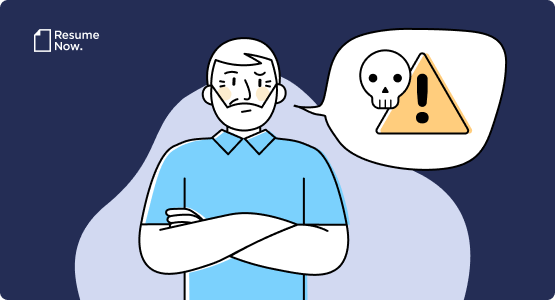
The Most Dangerous Jobs in America: Some Pay Less Than $40K, Others Top $190K
Resume Now s report reveals the highest and lowest paying dang...
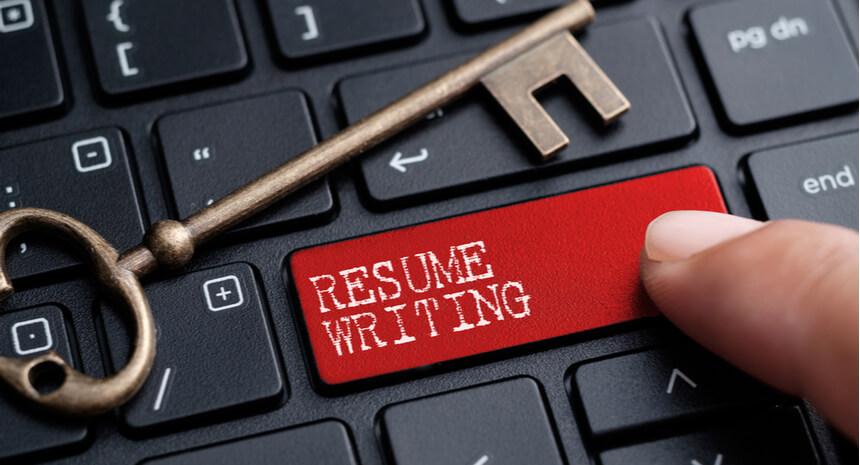
How to Write a Resume: Guide & Examples for 2025
If you re wondering how to write a resume that grabs attenti...
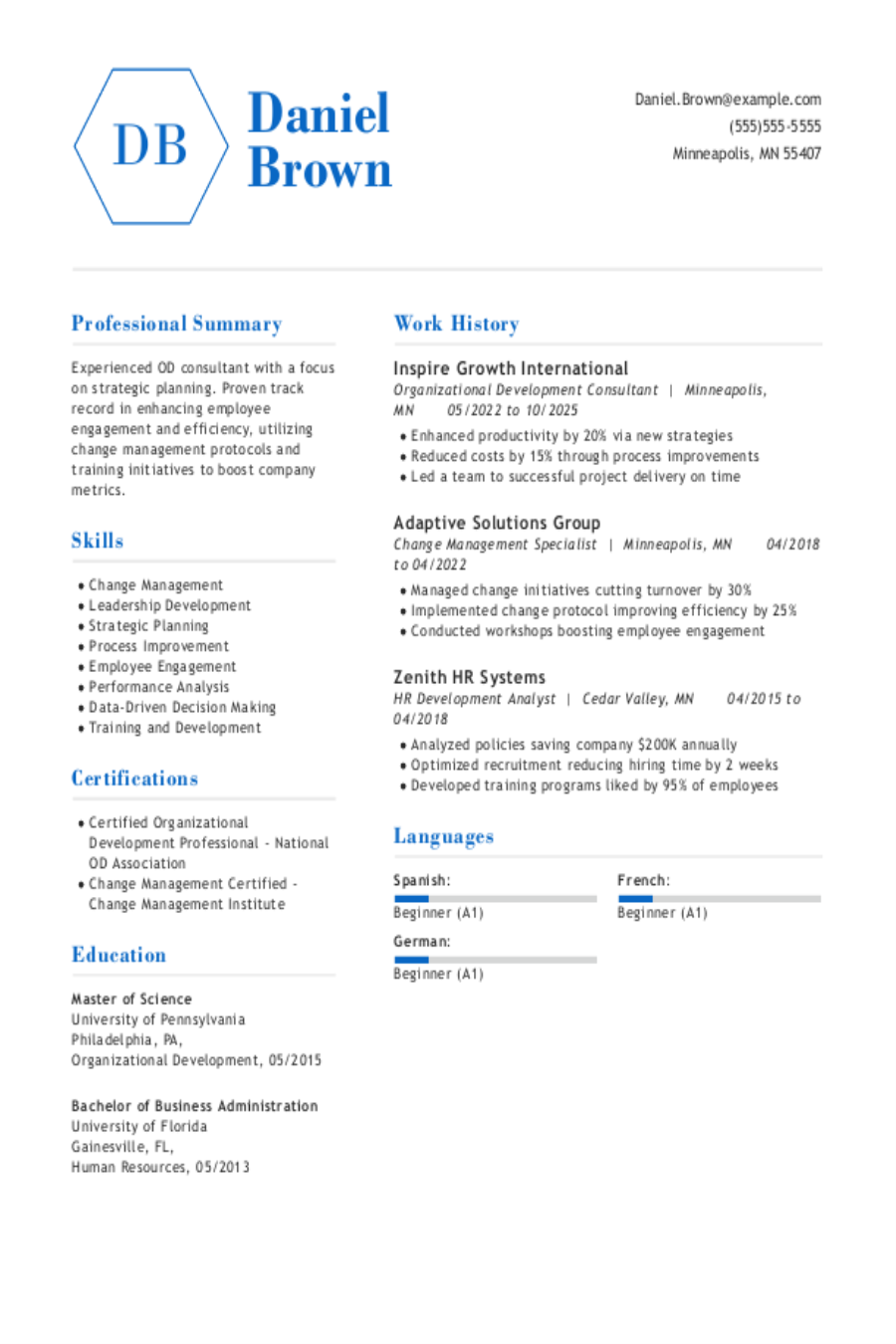
Organizational Development Consultant Resume Example
Build & download your Organizational Development Consultant re...
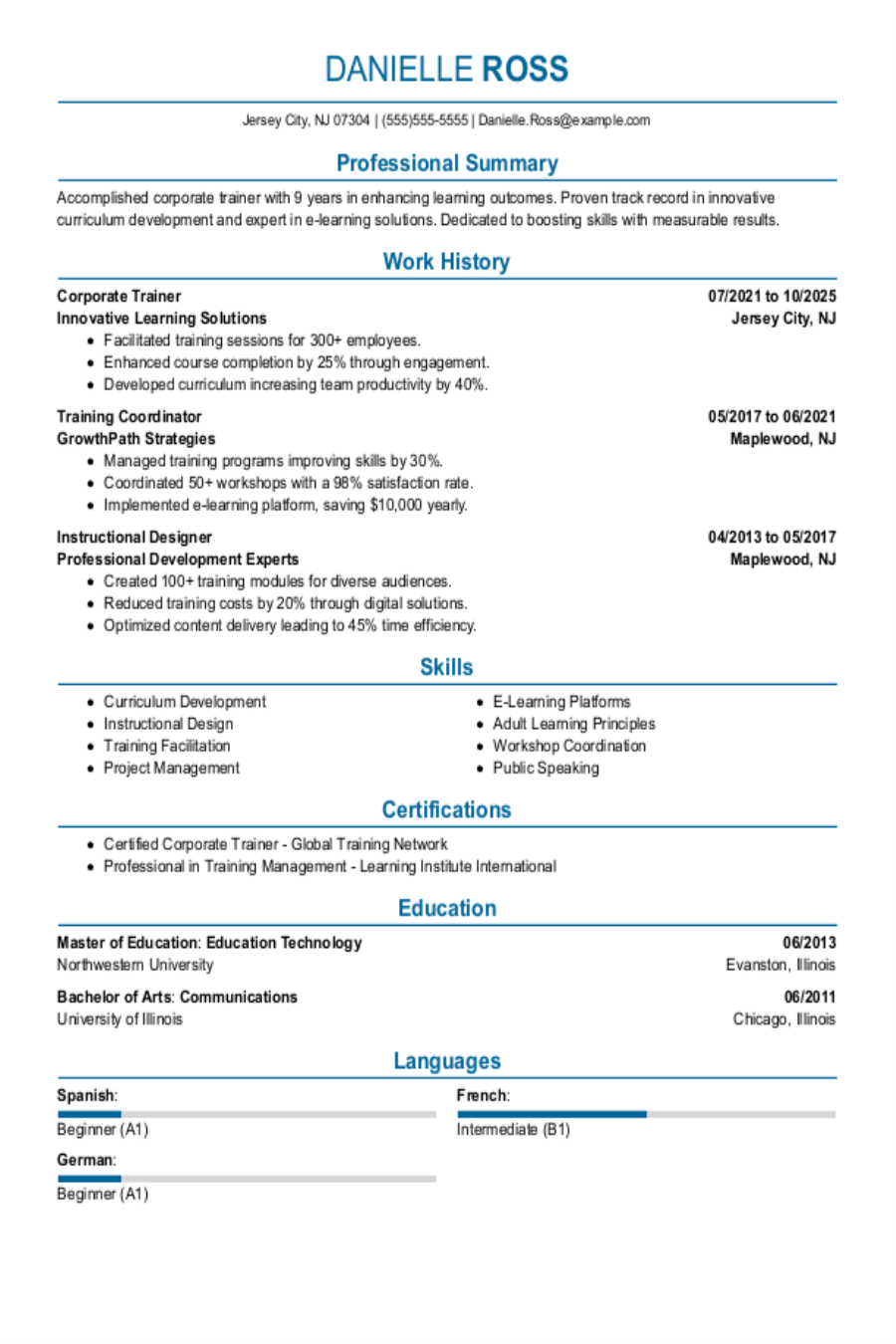
Trainer Resume: Examples, Template & How-to Guide
Make a trainer resume that gets interviews. Use our writing gu...

